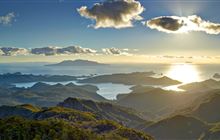Modernising conservation legislation
Introduction
Modernising conservation legislation is a significant step toward thriving nature.We are at a defining moment for nature – we need to act now to tackle the challenges that threaten biodiversity.
Te Mana o te Taiao – Aotearoa New Zealand Biodiversity Strategy 2020 provides a guide for all of Aotearoa to work together to protect and restore nature.
A priority for delivering Te Mana o te Taiao is tūāpapa – getting the system right. Reversing biodiversity decline requires better systems, including legislation.
Our current conservation laws are a web of 24 acts that are complicated and inconsistent. Most of them are decades old and do not account for modern pressures like climate change. They don't reflect our evolving understanding of the principles of the Treaty of Waitangi / Te Tiriti o Waitangi.
Modernising conservation legislation will be a significant step towards a healthy, vibrant and thriving natural environment.
Conservation law reform
We are taking a phased approach to modernising the conservation system.
Reforming conservation legislation is a significant project that will take time. There are some changes we can make to the legislation in the short and medium-term as we establish a foundation for comprehensive reform.
Roadmap
The conservation law reform roadmap sets out our work over the coming years to improve legislation.
Conservation law reform roadmap – updated May 2022 (PDF, 143K)
Public involvement
There will be plenty of opportunity for the public to have a say in any changes.
The roadmap shows when we intend to engage with the public on each legislative project. The roadmap will be updated regularly to help people plan their engagement.
Projects in the roadmap
Preparing for conservation law reform
We are beginning to prepare to reform the full suite of conservation law.
An important part of this is examining how the laws currently function. We are also beginning to build an understanding of the conservation aspirations of New Zealanders.
Trade in Endangered Species Act 1989
The Trade in Endangered Species Act 1989 (TIES Act) has not kept up with new developments and best practice. This makes it difficult to implement effectively.
Cabinet approved changes to the TIES Act in 2020. A Bill is being drafted to repeal and replace the TIES Act, for likely introduction in 2024.
Cabinet material about the Trade in Endangered Species Act 1989 review
Conservation management and processes amendments
The Conservation Management and Processes (CMAP) Bill will improve targeted areas of conservation legislation.
Navigating management planning and concessions processes can be slow and challenging. This affects conservation values and people engaging with public conservation lands and waters.
The proposals in the CMAP Bill aim to make the legislation more workable for everyone. They will also help these systems keep pace with societal and technological changes.
Review of the Wildlife Act 1953
We are undertaking a review of the Wildlife Act 1953.
The current Act is not fit for modern conservation management. It lacks the tools we need to protect threatened species. It also prevents fulfilment of some obligations under Te Tiriti o Waitangi.
The 70-year-old Wildlife Act 1953 will be repealed and replaced with modern, more fit-for-purpose species legislation to better protect native species.
More about the review of the Wildlife Act 1953
Stewardship land reclassification
The Minister of Conservation is proposing changes to make it easier to reclassify stewardship land.
Reclassifying stewardship land will ensure land with conservation and cultural values is protected for future generations. Most stewardship land has not yet been reclassified due to the scale and complexity of the task.
The Government has announced measures to improve the process for reclassifying stewardship land. This includes:
- changing the legislation to improve the process for the Minister of Conservation to reclassify and dispose of stewardship land
- establishing two national expert panels (the national panels) to assess stewardship land and make recommendations to the Minister of Conservation on revised classifications.
More about stewardship land reclassification
Hauraki Gulf marine protection
Revitalising the Gulf: Government action on the Sea Change Plan is the Government’s strategy for managing one of the country’s most valued and intensively used coastal areas.
DOC and Fisheries New Zealand are implementing an integrated package of fisheries management and marine conservation actions to improve the health and mauri of the Hauraki Gulf.
Marine protected areas reform
There are multiple issues with the Marine Reserves Act and the current approach for establishing marine reserves and other marine protected areas (MPA).
Updating MPA legislation is a key part of the Cabinet-agreed oceans and fisheries work programme.
MPA reform can create a strategic, nationally coordinated framework for marine protection. Modernised legislative tools and processes will improve integration with wider marine use.


